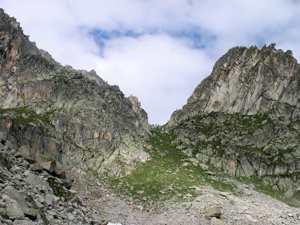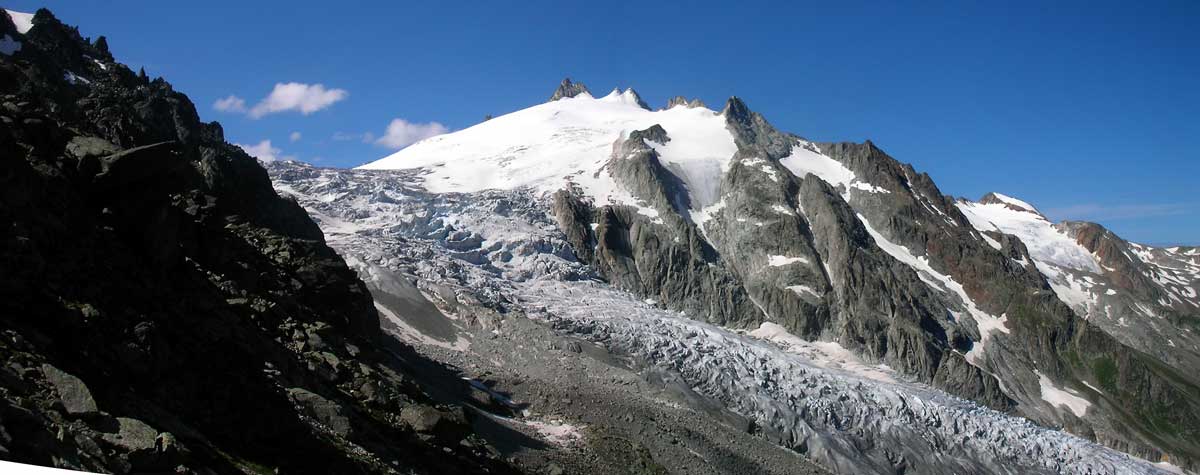George went on the hard route via Fenêtre d'Arpette, the highest point on the TMB, together with two members of the 'confort' group and all of the 'classique' group. Jean and the rest of the confort group took the alternative via Alp Bovine. The mules were conveyed to Trient by truck.
 Fenêtre d'Arpette route
Fenêtre d'Arpette route
We had been told the night before that the route offers perhaps the most spectacular views of the entire tour. But it is long, strenuous and requirs care, although it is not dangerous. So we set out at the unusually early hour of 7 am, led by Mathieu, the guide of the classique group, who set a pace a little quicker than the 'confort' group were used to. Soon the Fenêtre came into sight high above us at the top of a rock-strewn slope. The col that must have acquired its name because of its steep shoulders and narrow gap creating a 'window' through which hikers in both directions catch a spectacular view of a vast terrain on the other side. When we caught sight of the Fenêtre it seemed that we might reach it in an hour or so.
In reality it took us about 2.5 hours! The last portion of the climb to the col was the steepest path we had walked. It was a zig-zag route over medium-sized boulders requiring judgement of the best foot position on most steps. But with care and the help of Mathieu we eventually reached the col and were duly overwhelmed with the entirely fresh view onto ranges of mountains on the north side of the Mont Blanc massif and more distant ranges that struck our eyes:

In addition, we found ourselves close to the impressive Trient glacier just to the left of and below the Fenêtre:

 After feasting our eyes and slaking our thirst for a good while (enhanced by a drop of grappa from the flask that Mathieu passed around), we looked for the descending path. The large boulders at our feet looked unpromising and the terrain fell away at an even steeper gradient that the ascent on the other side. In fact the path took a steeply descending diagonal route that cut away so quickly from the col that is was invisible from it. The descent was more demanding that the climb up to the col. When Mathieu eventually called the lunch halt at around 11:30 we were all delighted. We were even more delighted by the
After feasting our eyes and slaking our thirst for a good while (enhanced by a drop of grappa from the flask that Mathieu passed around), we looked for the descending path. The large boulders at our feet looked unpromising and the terrain fell away at an even steeper gradient that the ascent on the other side. In fact the path took a steeply descending diagonal route that cut away so quickly from the col that is was invisible from it. The descent was more demanding that the climb up to the col. When Mathieu eventually called the lunch halt at around 11:30 we were all delighted. We were even more delighted by the picnic, involving the usual excellent salad, jambon cru sandwiches and cheese, but unusually rounded off by coffee made from granules and a flask of hot water and accompanied by lovely chunks of chocolat noir. Although the terrain was rocky, everyone found a spot to stretch out for the traditional short siesta before continuing our descent.
picnic, involving the usual excellent salad, jambon cru sandwiches and cheese, but unusually rounded off by coffee made from granules and a flask of hot water and accompanied by lovely chunks of chocolat noir. Although the terrain was rocky, everyone found a spot to stretch out for the traditional short siesta before continuing our descent.
The last portion of the route was undemanding but continued to offer excellent views of the Trient glacier and the bisse (network of irrigation channels) that flows from it. Eventually, the path reaches a wide track. An information panel informed us that the track has served in the 19th century for the transport by mule of ice cut from the glacier to the valley where it was loaded onto trains for sale in Paris and other cities.
We eventually arrived at around 3 pm at the Relais de Mont Blanc in Trient, where we were able to enjoy a few beers before the arrival of the remainder of the 'confort' group.
Alp Bovine route
When we started breakfast, the classique group had already departed. There was some time to spare so we wandered around the very attractive grounds of the Relais d'Arpette. They even have some chamois in a little pen - an opportunity to see them close up. So many times during our walk we have seen them in the far distance, munching away at the bushes.
Even with the binoculars we could see few details and certainly couldn't tell whether they were wild ones.
We cut across the fields to Champex d'En Haut and then went along the little road, losing some height until we reached Champex d'En Bas. Then we went into the woods and walked up a steep path on the side of the mountain, with views back towards La Fouley.
We came to a clearing, whereupon one of the group reminded us that it was 14th July. She took up her harmonica and all those that knew the words joined her in singing the Marseilleise. As we were going to remain in Switzerland for the rest of the day, we would not be treated to the customary evening firework displays and performances by fireman's bands.
After mounting a little further to Plan de l'Eau, we came to a clearing with a clear view below us of the Rhone Valley stretching a long way into the distance. The town of Martigny was directly beneath us. It was a shocking contrast to see this valley criss-crossed by all sorts and sizes of roads and the big buildings generally associated with towns. We wondered what it was like when people walked instead of using motor vehicles.
Diego pointed out some interesting plants to us. First Vérâtre - a toxic plant. It's big - similar to the yellow gentian. Apparently it can cause sickness and diarrhoea but is also used as a component in medicines and used to be a traditional cure for various maladies.
After some more tough uphill walking without much shade from the sun we reached a wide open green sloping field near to Alp Bovine where we stopped for a picnic at about 12.30.
Nearby was a big herd of black cows with big horns (of the Hérens breed). They have big horns and each cow has a big bell on a wide leather belt round its neck. The bells make a pleasant sound across the hillside.
As usual we all tried to doze a bit after the meal,
but insects kept crawling all over us. When we looked up we saw that most of the part had moved on, so we followed them up the remaining hill to the Buvette at the Alpage de Bovine (1987 m). There we had a coffee and cake and were once again exposed to the view of the Rhone Valley below us.
We walked on, only to discover that we hadn't quite reached the top of the hill. But we came to Portalo (at 2049 m) beyond which the path appeared to descend through the woods.
The second interesting plant that Diego identified was the Millepertuis (St Johns Wort). It's flowers are yellow but when you rub them against the skin they produce a red colour; he told us it has been used as a red dye. And it's also popular as a herbal medicine for treating depression and anxiety. And it can be used to cure skin irritations.
By about 4.15 we emerged from the woods at Col de la Forclaz. We had been rather baffled that a col would be well on the way down our path. The explanation was that it is the highest point on a busy road that passed through.
It was a relief that this was not our destination as the location was unprepossessing in spite of a shop with ice cream. We dropped down through a field and then crossed a fast road and walked along side it for a few hundred metres before dropping down again on the path to Trient.
Trient is a small gathering of houses round a pretty little church on a mound. On one side is the Glacier des Grandes.
After walking past the church and turning into a quite road we reached the Relais de Mont Blanc by about 4.30. We were very surprside to see that the classique group had beaten us to it.
We had an attractive but very small room. There was a nice view of the church from the window. We spent the early part of our last evening chatting with the other members of our group. The meal was soup, crudités, tomato fondue over potatoes and ice cream. The tomato fondue was placed on the table over a heater but was tipped over potatoes (like raclette) instead of being picked up on pieces of bread etc. We like it better that way. This fondue appears to be made from large quantities of well-cooked tomatoes with garlic and good quantities of Swiss cheese melted in.
During the meal we all exchanged names, addresses, phone numbers and email addresses so that we can keep in touch.
After the meal a walk round the village and then back to bed.
| Diary of fifth day |